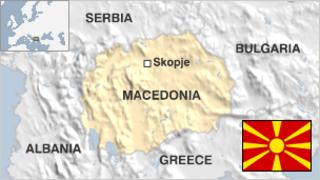Macedonia country profile
Macedonia was spared the inter-ethnic violence that raged elsewhere in the Balkans following the break-up of Yugoslavia in the early 1990s, but came close to civil war a decade after independence.
Rebels staged an uprising in early 2001, demanding greater rights for the ethnic-Albanian minority.
After months of skirmishes, EU and Nato support enabled the authorities to strike a peace deal. Albanian fighters laid down their arms in return for greater minority representation.
International recognition of the country’s split from Yugoslavia in 1991 was held up over Greek fears that its name implied territorial ambitions toward the northern Greek region of Macedonia. In 2018 Macedonia and Greece agreed on a new name – the Republic of North Macedonia – but a referendum in Macedonia failed to secure a large enough turnout to validate the Yes vote.
FACTS
Republic of Macedonia (listed by the UN as The former Yugoslav Republic of Macedonia)
Capital: Skopje
Population 2.1 million
Area 25,713 sq km (9,928 sq miles)
Major languages Macedonian, Albanian
Major religions Christianity, Islam
Life expectancy 73 years (men), 77 years (women)
Currency denar
LEADERS
President: Gjorge Ivanov
Professor Gjorgje Ivanov was sworn in as Macedonia’s fourth democratically-elected president on 12 May 2009. He was re-elected in April 2014.
Although he was put forward as a presidential candidate by the governing VMRO-DPMNE party, he is not a member.
His predecessor, Social Democrat Branko Crvenkovski, won praise in the West for supporting reconciliation with the substantial Albanian minority.
Macedonia’s presidents are directly elected for a five-year term. The president appoints the prime minister, and legislative power is vested in parliament.
Prime minister: Zoran Zaev
Social Democrat leader Zoran Zaev and his coalition partners representing Macedonia’s ethnic-Albanian minority formed a government in May 2017, ending a lengthy political deadlock.
Until he was given written guarantees, President Gjorge Ivanov delayed approving the coalition for fear that empowering the large Albanian minority could threaten national unity.
Macedonia had been without a functioning government since 2015, when it fell into turmoil over a wiretapping scandal that brought down the nationalist VMRO-DPMNE party.
MEDIA
Television is Macedonia’s most popular news medium. Public networks face stiff competition from commercial stations, which dominate the ratings.
TIMELINE
Some key dates in the Macedonia’s history:
1913 – Ottoman rule in Europe ends after five centuries. Macedonia is partitioned between Serbia, Bulgaria and Greece. What is now independent Macedonia is incorporated into Serbia.
1914 – First World War. Macedonia is occupied by Bulgaria.
1918-19 – Macedonia becomes part of Serbia again. The Kingdom of Serbs, Croats and Slovenes is founded, and is renamed Yugoslavia in 1929.
1945 – Establishment of Yugoslav socialist federation, comprising six republics, including Macedonia.
1980s – Rise of nationalism among federation’s constituent republics.
1991 – Declaration of independence. International recognition is slow because Greece objects to the use of the name Macedonia, the same as one of its own provinces.
2001 – Uprising by ethnic Albanians. Rebel militia engages in skirmishes which bring country to brink of civil war. Peace deal involves greater recognition of Albanian rights in exchange for rebel pledge to lay down arms.
2018 October – Referendum to change country’s name to North Macedonia declared invalid due to low turnout.
Approval would have opened way for Greece to stop blocking Macedonia’s bid to join EU and Nato, under a June 2018 agreement.
Source: Read Full Article



